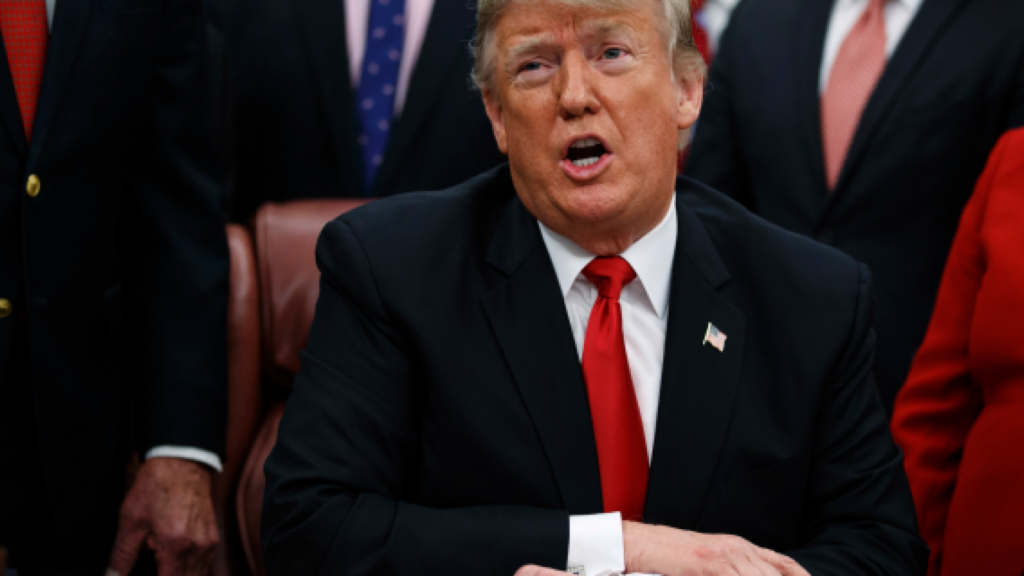Satellite photos showing new activity at a North Korean rocket launch site raised fresh doubts that Kim Jong Un will ever give up his drive for nuclear weapons, yet talks continue and President Donald Trump said he was still hoping for the agreement that eluded the leaders at last week’s summit.
The president said his relationship with the North Korean leader remains “good” even though Trump walked away from negotiations at their high-profile meeting in Vietnam. He said then that the North’s concessions on its nuclear program weren’t enough to warrant sanctions relief, and he said Wednesday he’d be unhappy if reports prove true that Kim is rebuilding a launch site after promising in Vietnam to extend his ban on nuclear and rocket tests.
“I would be very, very disappointed in Chairman Kim,” Trump said when reporters asked him about reports of new work at the Sohae Satellite Launch Station, which is tucked into the hills northwest of Pyongyang. “I don’t think I will be” disappointed, Trump said, “but we’ll see what happens.”
Past administrations discovered the perils of trying to do business with North Korea, which has a history of backing out of agreements. Trump believes his discussions will be different because Kim he has publicly announced his desire to focus on economic development in his reclusive nation, which is suffering under harsh U.S. and international sanctions.
Trump has favored direct talks with Kim, but with no third summit under discussion right now, the next stage of negotiations is likely to be conducted at lower levels. Trump’s envoy to North Korea, Steve Biegun, had lunch Wednesday at the State Department with his counterparts from Japan and South Korea. The South Koreans have proposed semiofficial three-way talks with the United States and North Korea as it works to put nuclear diplomacy back on track.
Suh Hoon, the director of South Korea’s National Intelligence Service, told his nation’s lawmakers in Seoul that North Korea was restoring facilities at a rocket launch site it had dismantled last year in a goodwill measure.
Meanwhile, 38 North, a website specializing in North Korea studies, said commercial satellite imagery indicates the rebuilding started between Feb. 16 and March 2. And the Center for Strategic and International Studies, a think tank in Washington, issued another report saying satellite imagery taken Saturday — just two days after the summit ended — showed North Korea “pursuing a rapid rebuilding” of the rocket site.
Some analysts think the work is a signal that Kim is getting ready to conduct more tests, but others suggest he’s just registering his disappointment that no agreement was reached at the summit. Trump himself added to the confusion, saying his administration had a hand in the report on Sohae being made public.
“It’s a very early report. We’re the ones that put it out,” Trump said without elaborating.
Joel Wit, a North Korea proliferation expert who helped negotiate with North Korea in the mid-1990s, said the new work at Sohae is Kim’s way of showing that he’s “getting impatient with lack of progress in negotiations.”
“We have to watch to see what else happens,” Wit said. “It’s a space launch facility and has been used to send satellites into space. … Problem is, some of the technologies are the same.”
He said there is no evidence that North Korea’s work at the site signals Kim is preparing to test another intercontinental missile. He said North Korea has never tested an ICBM at Sohae. “Preparations for any launch would require a wide range of activities not observed at the site,” Wit said.
Trump and Kim, who also met in Singapore last year, have not said if there will be a third summit. For now, discussions with North Korea will be conducted by their subordinates. Biegun, the U.S. envoy to North Korea, gave members of the Senate Foreign Relations Committee a classified update Tuesday afternoon on Capitol Hill.
Sen. Bob Menendez of New Jersey, the ranking Democrat on the committee, said that before any further summits between the leaders, there must be lower-level discussions to determine how far Kim is willing to go to denuclearize. That’s all the more important “to continue to test the North Koreans’ willingness now that they know they’re not going to get an easy deal,” Menendez said.
Committee Chairman Jim Risch, R-Idaho, said Biegun has a vision of where the U.S. wants to take the talks.
“He has clear knowledge of the steps that it takes to get there, and he’s laid that out for the North Koreans,” Risch said.
There’s no framework agreement “to put the details on it yet,” he said. But he added: “The differences have been narrowed.”
Less upbeat, Committee member Edward Markey, D-Mass., said the work at Sohae could be a sign that Kim is more interested in getting concessions from the U.S. than conducting good faith efforts to denuclearize. He said he’s also worried that future satellite launches at Sohae could help Kim further his work on ballistic missiles to threaten the U.S. and its allies with a nuclear attack.
“President Trump never codified in writing North Korea’s missile and nuclear testing freeze,” Markey said. “Without that formal commitment, North Korea might claim it is doing nothing wrong and derail the fragile diplomatic process underway.”
(AP)











